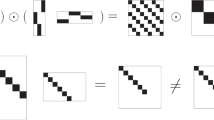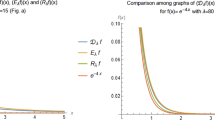Abstract
Accurate detection of signal components is a frequently-encountered challenge in statistical applications with a low signal-to-noise ratio. This problem is particularly challenging in settings with heteroscedastic noise. In certain signal-plus-noise models of data, such as the classical spiked covariance model and its variants, there are closed formulas for the spectral signal detection threshold (the largest sample eigenvalue attributable solely to noise) for isotropic noise in the limit of infinitely large data matrices. However, more general noise models currently lack provably fast and accurate methods for numerically evaluating the threshold. In this work, we introduce a rapid algorithm for evaluating the spectral signal detection threshold in the limit of infinitely large data matrices. We consider noise matrices with a separable variance profile (whose variance matrix is rank 1), as these arise often in applications. The solution is based on nested applications of Newton’s method. We also devise a new algorithm for evaluating the Stieltjes transform of the spectral distribution at real values exceeding the threshold. The Stieltjes transform on this domain is known to be a key quantity in parameter estimation for spectral denoising methods. The correctness of both algorithms is proven from a detailed analysis of the master equations characterizing the Stieltjes transform, and their performance is demonstrated in numerical experiments.
Similar content being viewed by others
References
Bai, Z., Silverstein, J.W: Spectral Analysis of Large Dimensional Random Matrices, Springer Series in Statistics. Springer, Berlin (2009)
Bao, Z., Ding, X., Wang, K.: Singular vector and singular subspace distribution for the matrix denoising model. Ann. Stat. 49(1), 370–392 (2021)
Benaych-Georges, F., Nadakuditi, R.R.: The singular values and vectors of low rank perturbations of large rectangular random matrices. J. Multivar. Anal. 111, 120–135 (2012)
Bhamre, T., Zhang, T., Singer, A.: Denoising and covariance estimation of single particle cryo-EM images. J. Struct. Biol. 195(1), 72–81 (2016)
Biglieri, E., Calderbank, R., Constantinides, A., Goldsmith, A., Paulraj, A., Vincent Poor, H.: MIMO Wireless Communications. Cambridge University Press, Cambridge (2007)
Buja, A., Eyuboglu, N.: Remarks on parallel analysis. Multivar. Behav. Res. 27(4), 509–540 (1992)
Cordero-Grande, L.: MIXANDMIX: Numerical techniques for the computation of empirical spectral distributions of population mixtures. Comput. Stat. Data Ana. 141, 1–11 (2020)
Couillet, R., Debbah, M.: Random matrix methods for wireless communications. Cambridge University Press, Cambridge (2011)
Couillet, R., Hachem, W.: Analysis of the limiting spectral measure of large random matrices of the separable covariance type. Random Matrices: Theory and Applications, 3(4) (2014)
Dahlquist, G., Björck, Å: Numerical Methods. Prentice Hall Inc, Hoboken (1974)
Ding, X., Yang, F.: Spiked separable covariance matrices and principal components. Ann. Stat. 49(2), 1113–1138 (2021)
Dobriban, E.: Efficient computation of limit spectra of sample covariance matrices. Random Matrices: Theory and Applications, 4(4) (2015)
Dobriban, E.: Permutation methods for factor analysis and PCA. Ann. Stat. 48(5), 2824–2847 (2020)
Dobriban, E., Leeb, W., Singer, A.: Optimal prediction in the linearly transformed spiked model. Ann. Stat. 48(1), 491–513 (2020)
Dobriban, E., Owen, A.B.: Deterministic parallel analysis: An Improved Method for Selecting Factors and Principal Components. Journal of the Royal Statistical Society Series B (Statistical Methodology) (2018)
Donoho, D.L, Gavish, M., Johnstone, I.M: Optimal shrinkage of eigenvalues in the spiked covariance model. Annals of Statistics, 46(6) (2018)
El Karoui, N.: Spectrum estimation for large dimensional covariance matrices using random matrix theory. Ann. Stat. 36(6), 2757–2790 (2008)
Gavish, M., Donoho, D.L.: Optimal shrinkage of singular values. IEEE Trans. Inf. Theory 63(4), 2137–2152 (2017)
Geman, S.: A limit theorem for the norm of random matrices. Ann. Probab. 8(2), 252–261 (1980)
Hong, D., Balzano, L., Fessler, J.A.: Towards a Theoretical Analysis of PCA for Heteroscedastic Data. In: 54Th Annual Allerton Conference on Communication, Control, and Computing, pp 496–503. IEEE (2016)
Hong, D., Balzano, L., Fessler, J.A.: Asymptotic performance of PCA for high-dimensional heteroscedastic data. J. Multivar. Anal. 167, 435–452 (2018)
Hong, D., Balzano, L., Fessler, J.A: Optimally weighted PCA for high-dimensional heteroscedastic data. arXiv:1810.12862 (2018)
Horn, J.L.: A rationale and test for the number of factors in factor analysis. Psychometrika 30(2), 179–185 (1965)
Iain, M.: Johnstone, on the distribution of the largest eigenvalue in principal components analysis. Ann. Stat. 29(2), 295–327 (2001)
Kritchman, S., Nadler, B.: Determining the number of components in a factor model from limited noisy data. Chemom. Intell. Lab. Syst. 94(1), 19–32 (2008)
Kritchman, S., Nadler, B.: Non-parametric detection of the number of signals: Hypothesis testing and random matrix theory. IEEE Trans. Signal Process. 57(10), 3930–3941 (2009)
Ledoit, O., Wolf, M.: Spectrum estimation: A unified framework for covariance matrix estimation and PCA in large dimensions. J. Multivar. Anal. 139, 360–384 (2015)
Ledoit, O., Wolf, M.: Numerical implementation of the quEST function. Comput. Stat. Data Anal. 115, 199–223 (2017)
Leeb, W.: Optimal singular value shrinkage for operator norm loss. arXiv:2005.11807 (2020)
Leeb, W.: Matrix Denoising for Weighted Loss Functions and Heterogeneous Signals. SIAM Journal on Mathematics of Data Science Accepted (2021)
Leeb, W., Romanov, E.: Optimal spectral shrinkage and PCA with heteroscedastic noise. IEEE Trans. Inf. Theory 67(5), 3009–3037 (2021)
Marchenko, V.A, Pastur, L.A: Distribution of eigenvalues for some sets of random matrices. Mat. Sb. 114(4), 507–536 (1967)
Nadakuditi, R.R.: Optshrink: An algorithm for improved low-rank signal matrix denoising by optimal, data-driven singular value shrinkage. IEEE Trans. Inf. Theory 60(5), 3002–3018 (2014)
Nesterov, Y.: Lectures on Convex Optimization, volume 137 of Springer Optimization and Its Applications, 2nd edn. Springer, Berlin (2018)
Onatski, A.: Determining the number of factors from empirical distribution of eigenvalues. Rev. Econ. Stat. 92(4), 1004–1016 (2010)
Onatski, A., Moreira, M.J, Hallin, M.: Asymptotic power of sphericity tests for high-dimensional data. Ann. Stat. 41(3), 1204–1231 (2013)
Passemier, D., Yao, Jian-Feng: On determining the number of spikes in a high-dimensional spiked population model. Random Matrices: Theor. Appl. 1(01), 1150002 (2012)
Paul, D.: Asymptotics of sample eigenstructure for a large dimensional spiked covariance model. Stat. Sin. 17(4), 1617–1642 (2007)
Paul, D., Silverstein, J.W.: No eigenvalues outside the support of the limiting empirical spectral distribution of a separable covariance matrix. J. Multivar. Anal. 100, 37–57 (2009)
Raj Rao, N., Edelman, A.: The polynomial method for random matrices. Found. Comput. Math. 8, 649–702 (2008)
Shabalin, A.A., Nobel, A.B.: Reconstruction of a low-rank matrix in the presence of Gaussian noise. J. Multivar. Anal. 118, 67–76 (2013)
Silverstein, J.W.: Strong convergence of the empirical distribution of eigenvalues of large dimensional random matrices. J. Multivar. Anal. 55, 331–339 (1995)
Silverstein, J.W., Bai, Z.: On the empirical distribution of eigenvalues of a class of large dimensional random matrices. J. Multivar. Anal. 54, 175–192 (1995)
Tandra, R., Sahai, A.: SNR Walls for signal detection. IEEE J. Select. Top. Signal Process. 2(1), 4–17 (2008)
Tao, T.: Topics in random matrix theory american mathematical society (2012)
Yücek, T., Arslan, H.: A survey of spectrum sensing algorithms for cognitive radio applications. IEEE Commun. Surv. Tutor. 11(1), 116–130 (2009)
Zeng, Y., Liang, Y.-C.: Covariance based signal detections for cognitive radio. In: 2nd IEEE International Symposium on New Frontiers in Dynamic Spectrum Access Networks, pp 202–207. IEEE (2007)
Zeng, Y., Liang, Y.-C.: Eigenvalue-based spectrum sensing algorithms for cognitive radio. IEEE Trans. Commun. 57(6), 1784–1793 (2009)
Anru Zhang, T., Cai, T., Wu, Y., Heteroskedastic PCA: Algorithm, optimality, and applications. arXiv:1810.08316 (2018)
Acknowledgements
I thank Edgar Dobriban for helpful discussions and for pointing out the method from [15]. I also thank the reviewers for their helpful comments on the manuscript.
Funding
This work was supported by NSF BIGDATA award IIS 1837992 and BSF award 2018230.
Author information
Authors and Affiliations
Corresponding author
Additional information
Communicated by: Holger Rauhut
Publisher’s note
Springer Nature remains neutral with regard to jurisdictional claims in published maps and institutional affiliations.
Rights and permissions
About this article
Cite this article
Leeb, W. Rapid evaluation of the spectral signal detection threshold and Stieltjes transform. Adv Comput Math 47, 60 (2021). https://doi.org/10.1007/s10444-021-09890-7
Received:
Accepted:
Published:
DOI: https://doi.org/10.1007/s10444-021-09890-7
Keywords
- Spectral signal detection threshold
- Stieltjes transform
- Limiting spectral distribution
- Newton’s method
- Separable variance profile




